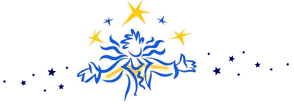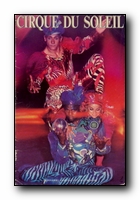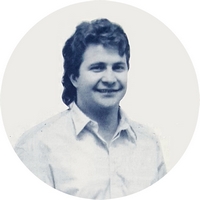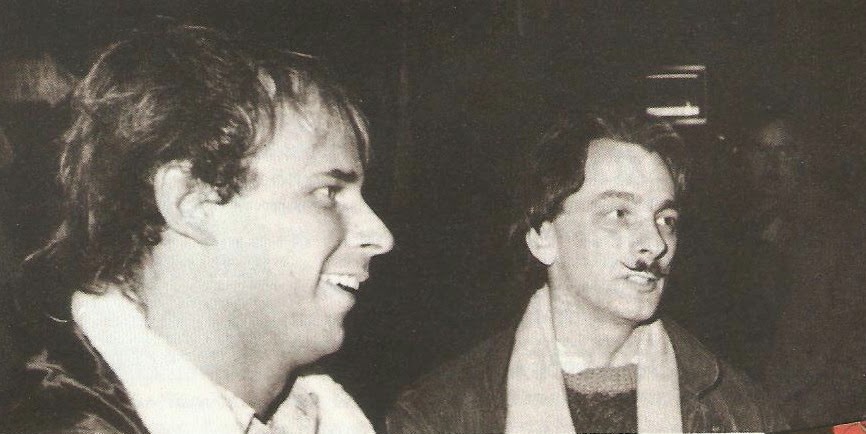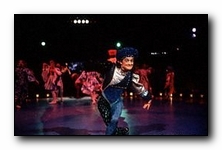

![]()
1980s
1982 · 19831984 · 1985
1986 · 1987
1988 · 1989
1990s
1990 · 19911992 · 1993
1994 · 1995
1996 · 1997
1998 · 1999
2000s
2000 · 20012002 · 2003
2004 · 2005
2006 · 2007
2008 · 2009
2010s
2010 · 20112012 · 2013
2014 · 2015
2016 · 2017
2018 · 2019
2020s
2020 · 20212022 · 2023
2024

RE-INVENTING RÉINVENTÉ
After Cirque du Soleil exploded onto the scene at the Los Angeles Festival, it went on to conquer the United States beginning its exponential growth phase. "It's extraordinary. Five years ago, we were a bunch of young, unemployed jugglers and clowns, trying to turn street performing into an art form," says Laliberté. "I'm doing what every kid dreams about: running away and joining the circus. The only problem is that it's my circus - and administrating is not quite the same as performing." Success exceeded management's expectations, but that success would be undercut by a number of internal crises. GROWING PAINS
Cirque's star contortionist Angela Laurier expressed her concerns about Cirque abandoning its integrity and original spirit in an on-camera interview for the film "A Circus in America" directed by La Presse reporter Natalie Petrowski, "Now everybody is more individualized. The Cirque isn't the same as it was before. It's much more disciplined and more about performance than in the past. This worries me, by growing too fast the Cirque risks losing its originality, its spirit . . I feel like I'm distancing myself from my values. The artists feel ill-at-ease in their own skin because of stress. At the beginning it was about exploration of a circus but now it's just a routine." Guy Laliberté certainly did not appreciate the critique of his company from an insider and chose not to renew Angela Laurier's performance contract. (Natalie Petrowski is shunned by Laliberté to this day; she was never again granted an interview and was effectively banned from all show premieres.) At the end of the tour, 23 of 30 performers quit and the press have a field-day. "This is the way they'd been living for the past five years," Laliberté said. "This is the way we've been living for the past five years," said Laliberte. "Each year, there has been a changeover in personnel, I don't understand why they (the media) are making a big deal about it now." After a long stretch on the road, he added, "they felt the need to renew family ties and see friends. I respect that." But artist squabbles were the least of Laliberté's issues. CRISIS AT THE TOP The direction of the Cirque du Soleil has always been a tumultuous and fractious affair. For much of its history up to this point the company had three main managers: Guy Laliberté, Daniel Gauthier, and Normand Latourelle. Daniel Gauthier would take care of Finance and Administration, Normand Latourelle would handle Marketing and Operations, and Guy Laliberté would be in charge of Business Development and Creation.
One reason, given in Jean Beaunoyer's book "Dans les coulisses Cirque du Soleil", was Laliberté's pet project Éclipse, a multidisciplinary concept with American backers to feature a revolutionary new tent design, which had cost the company three quarters of a million dollars with nothing to show for it. Both Gauthier and Latourelle were said to be outraged at the causal spending. Daniel Gauthier agreed the bleeding had to be stopped and Laliberté was outsted. The following day Gauthier reneged, citing Guy's newly negotiated contracts for performances in Las Vegas, and in the end it was Latourelle who was written out of the story. But there were other reasons too... Franco Dragone abruptly left after he finished directing Le Cirque Réinventé, feeling that upper management (namely Laliberté, who was rumored to have judged the show to be "shameful") encroached too much on his artistic freedom. "When I learned that those who claimed the most success for the tour were the ones who had slowed production the most, I knew I had made the right decision to leave," Dragone was quoted as saying at the time. Years later, his view mellowed a bit, saying "Sometimes we disagreed, but Guy Laliberté trusted what I was doing." (Laliberté subsequently lured him back to the Cirque fold by offering to give Dragone the post of Director of Creation, Research and Development and the artistic freedoms that went along with it. Dragone accepted and created Nouvelle Éxperience.) Guy Caron would also tender his resignation, citing artistic differences over what to do with the money generated by Réinventé's success as the reason for his departure. Laliberté saw expansion and the start of a second show (the aforementioned Éclipse) while Caron wanted the money to be saved and pooled, with a portion being reinvested in his National Circus School. "At the artistic level," Laliberté explained, "we were always on the same wavelength. Caron and I had the same goal: creating a circus in Quebec. But we had a difference of opinion about how to make it happen."
An agreement is never met and Caron, along with a large number of artists loyal to him, depart. "In the beginning, it was about achieving an artistic dream. It was hard for (my colleagues) to understand that I was always thinking four or five or 10 years in advance," Laliberté added. When the money started pouring in, "I was always saying, 'OK, that could just be there for the moment. If you want to capitalize on that, you have to reinvest that money in a new show.' ... I was trying to explain to them, we should create an autonomous feeding circle, where the success of one show will generate money to create another show." Because of the tensions within the upper eschelons of the company, plans for the new show were shelved. Guy Caron would become the Director of the National Arts Centre du Cirque in Chalon-sur-Marne in France. Laliberté and Gauthier would go on to run Cirque du Soleil together. And Gilles Ste-Croix would step in as the company's new Artistic Director, charged with putting Réinventé back together. GILLES STE-CROIX STEPS IN Guy Laliberté made the announcement "and I didn't even know it," Ste-Croix said of the news. "He hadn't even warned me!" But he had quite the challenge to overcome: "Faced with the threat of a complete resignation, I decided that it was better to let go those who wanted to go and start all over again," he said. About 75% of the performers in 1988's version of Réinventé had quit or were let go for one reason or another. Recall many complained about pay and conditions; therefore, one of the first things Ste-Croix did was to improve the working environment as much as possible. "It was impossible to continue working at this pace," with just twenty-seven or so artists on stage. So he decided to bring in more artists to relieve performance pressures, increased the salaries by 25% (artists now earned between $90 and $115 USD per show), pay by the show rather than by the week, house individually for more privacy (up to this point artists shared accommodations - some on site), and decreed that they'd never play more than 9 shows a week. The Cirque is also featured in Vanity Fair, Time, Life, People, Newsweek, Maclean's, and in newspapers such as the New York Times, the San Francisco Chronicle, the Washington Post, and USA Today. Even the major television networks are on the beat. When asked if the 1989 show would be the same as the 1988 show, Artistic Director Ste-Croix said, "This year's show will be more theatrical and demonstrate more acrobatic skills than ever before. It will also be a more complete show because some of the events will be taking place outside the ring." The troupe’s current edition boasts all new acts and a more lighthearted, comic flavor than the 1988 edition. Ste. Croix also points out that last year’s entry "was what we call 'fleur bleue' -- soft edges, romance, and characters acting like 'poupees', little dolls. Now we have characters more like humans, and the design is more hard-edged and geometric." Miami, Chicago, and Phoenix were added to the tour route, and another 405,950 spectators revel in the performances. However, Sylvie Drake of the Los Angeles Times found herself a bit disappointed with the Cirque of 1989. "One can't shake the feeling that something is missing in this new edition of Le Cirque. Call it a nuance, a shade, a hair of that early innocence and ebullience ... Le Cirque is still a remarkable entertainment. It's just that we all know by now how remarkable it can be and won't settle for less." OTHER REASONS TO CELEBRATE In September 1988, Cirque du Soleil purchased a new big top from Bourdin Enterprises in France. It cost $300,000, red poles, cupole, cornices, chains and pegs not included. It's made of shiny PVC, not canvas. "After three years of touring, the old one was getting worn out," says Richard Bouthillier, technical director and vice president of the Cirque. "And it was leaking a lot." It holds 1,734 people - 400 chairs, and grandstands with cushions for the rest. It's big enough to hold the wooden ring, the moody purple theater lights, the five-piece band with synthesizers, the clowns and trapeze. Once the circus trucks arrive on site, 28 hours is all it takes to make camp (all 140,000 square feet of it. The pegs go down. The tent masts go up. The electrical system, phone system, water system and kitchen are set up. And then the tent, the bleachers, the stage ring, the lights. Very last, a wooden sidewalk is laid around the tent's edge. Very chic!
As Cirque du Soleil embarks on its sixth season, Guy Laliberte talks enthusiastically about "diversifying." Tours to Japan and Europe are on the horizon. An entirely new show with a new theme is in the works. When it’s ready, Soleil will have two troupes on the road, Ringling Bros.-style. The organization is also managing a growing number of offshoot enterprises: a circus school, a film and video outfit, several ticket outlets, and a merchandising unit. Though he refers fondly to Soleil's street-artist past, Laliberte acknowledges that he is running an entertainment corporation now: “For the first five years it was a family trip. Now it's become a business. But a goal and a big step is keeping the family spirit in the business. In the next five years we'll see just how much we can do with our success, financially and in the integrity of our performing. We want to go as far as we can and still keep the soul of Cirque du Soleil alive." SPOTLIGHT: LE GROUPE DU SOLEIL "An Idea... a Show... a Company? In the beginning, a handful of street performers met from time to time in Quebec to do a show. They couldn't have imagined that what they were creating would become an internationally known cultural enterprise. Now the head office of Le Cirque du Soleil is in Montreal, rather than on the street, in a newly renovated Fire Station nearby the St. Lawrence River. Fire Station Number 7 holds offices for President Guy Laliberté, Executive Vice President Daniel Gauthier, Vice President and Sponsorship Director Jean David, and some 20 others who complete this team. And, as of August 1989, Fire Station Number 7 is also home of derived companies of Cirque du Soleil, organized under the Le Groupe du Soleil umbrella. Here are thumbnail sketches of the various tools at the Groupe's disposal:
Why did they choose to call themselves "Groupe du Soleil" when Cirque du Soleil was already well known? The answer is simple: as the Groupe's mission states, it's ambitions are not limited to shows. The Groupe also works in other domains, including production of records and videos. It also develops services that support its artisitc activities: box-office systems, computer systems, and design and marketing of promotional products. "With the year 2000 glimmering on the horizon, we have a chance to become conspirators. We can act to create a better world. The power to do is in our hands. Let's use it with passion!" — Guy Laliberte 
 |


![[Back]](../images/arrow.gif)

